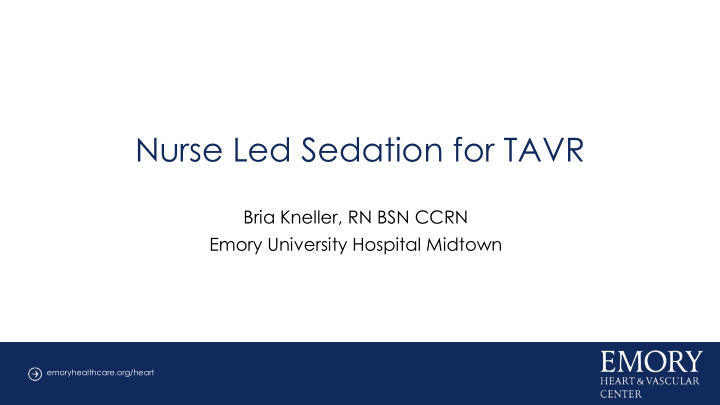



Nurse Led Sedation for TAVR Bria Kneller, RN BSN CCRN Emory University Hospital Midtown emoryhealthcare.org/heart
Disclosures • I, Bria Kneller, DO NOT have a financial interest, arrangement, or affiliation with one or more organizations that could be perceived as a real or apparent conflict of interest in the context of the subject of this presentation. emoryhealthcare.org/heart
Minimalist Approach • Use of procedural sedation/moderate anesthesia care is gaining popularity over General Anesthesia • Potential benefits: • No intubation; less respiratory compromise • Decreased vasopressor use • Shortened procedure time • Shorter hospital stay • Potential disadvantages • Use of TEE is challenging; may miss PVL • Patient discomfort emoryhealthcare.org/heart
What is Minimalist sedation? • No clear definition is listed • TVT registry lumps all non-GA cases together • MAC (Monitored Anesthesia Care) • NLS (Nurse Led Sedation) emoryhealthcare.org/heart
Emory Protocols for Sedation • Determine which patients are appropriate candidates for Minimalist • Perform Conscious Sedation algorithm • ASA Score • Mallampati score • H&P • Appropriate consents • Conscious sedation ‘ powerplan ’ emoryhealthcare.org/heart
Emory Protocols for Sedation • Heart Team decides if patient is scheduled for NLS, MAC or General Anesthesia based on protocol • Anesthesia Pre-operative Clinic performs consultation with patient the day before their procedure • RN meets patient in the pre-op area on the day of their procedure emoryhealthcare.org/heart
What does NLS look like? • RN assessment in the pre-op area • Allergies • Age • Hemodynamics • Baseline respiratory status, blood pressure and HR • Body habitus; frailty or obesity • hx of COPD/OSA/respiratory conditions • hx of HF (what is EF) • hx of stroke/dementia/neuro conditions • Home narcotic or benzo use • Patient comfort preference emoryhealthcare.org/heart
What does NLS look like? • 2 RNs circulate every TAVR • One of the RNs is primarily responsible for medication administration • Ensure patient’s position is comfortable before sedating • Protect elbows, heels and sacrum, arm position in radial access, lumbar support if needed, use of home CPAP, bair hugger • RN operates under “Moderate Sedation” protocol using narcotics and benzodiazepines primarily • RN assesses patient’s response to the medication throughout the procedure and communicates with Physicians about patient status • LOC, hemodynamics, breathing pattern, pain/anxiety emoryhealthcare.org/heart
What happens when things don’t go as planned? • Defibrillator pads placed prior to starting procedure • Venous sheath used as a central line • Vasopressors primed and are on “hold” • Anesthesia team is present in the department • An overhead page for “all available help” called • Airway and other emergency equipment in the room for every case • Crash cart, ambu bag, intubation box, IABP, pericardiocentesis tray emoryhealthcare.org/heart
Evaluation of MAC vs NLS emoryhealthcare.org/heart
Evaluation of our outcomes • Reviewed Emory Healthcare Database • 2012-2017 • Only included balloon expandable valves • Procedures performed under the “minimalist protocol” • Two groups • NLS- Conscious sedation delivered by RN (807 patients) • MAC- Moderate sedation delivered by Anesthesia (MD +/- CRNA)- (285 patients) emoryhealthcare.org/heart
Results NLS n=807 MAC n=285 p-value Clinical Results Procedure Room TIme 147 minutes 164 minutes 0.001 Conversion to general 2.1% 1.1% 0.22 anesthesia Conversion to open 0.74% 1.1% 0.63 surgery Survival to discharge 98.6% 99.7% 0.12 * No statistical difference in major/minor vascular complications, major/minor bleeds, CVA, new-onset AFIB, new pacemaker placement, or need for second valve emoryhealthcare.org/heart
Discharge Echo Outcomes Echocardiogram NLS MAC P-value metrics Ejection Fraction 54.5% 56.9% 0.029 Aortic Valve Area 1.91cm 2 1.79cm 2 0.01 Mean Gradient 11.5mmHg 11.8mmHg 0.47 emoryhealthcare.org/heart
Summary of Emory findings • Nurse-Led Sedation can be performed safely and effectively • Procedural outcomes with nurse-led sedation are similar to those with anesthesiologist-led moderate sedation • No clinically significant differences in post-deployment hemodynamics, vascular complications, or valve area • Nurse-led sedation is associated with significantly less procedure room time than anesthesia-led moderate sedation emoryhealthcare.org/heart
Thank you! • Bria.kneller@emoryhealthcare.org • Patricia.keegan@emoryhealthcare.org emoryhealthcare.org/heart
References • https://www.sciencedirect.com/science/article/pii/S19368 7981832524X • https://www.acc.org/latest-in- cardiology/articles/2017/07/19/15/42/the-evolution-of- transcatheter-aortic-valve-replacement • https://www.ncbi.nlm.nih.gov/pmc/articles/PMC6242923/ • https://www.ncbi.nlm.nih.gov/pmc/articles/PMC4004491/ emoryhealthcare.org/heart
Recommend
More recommend